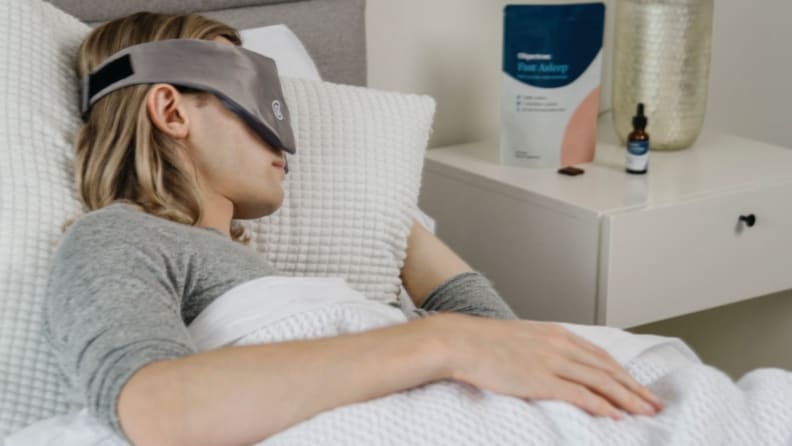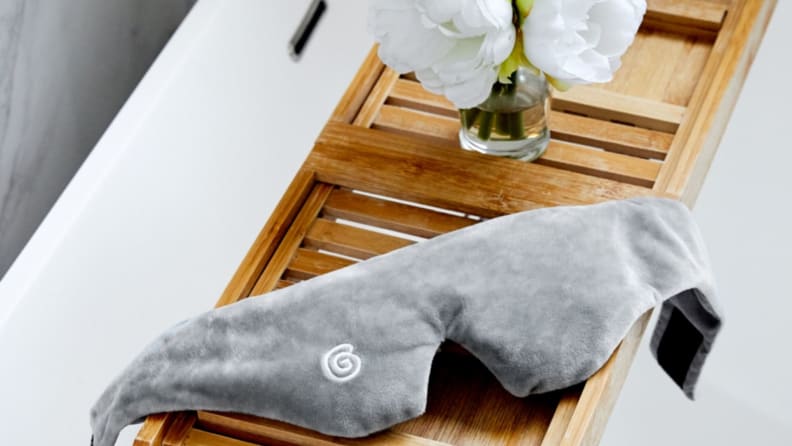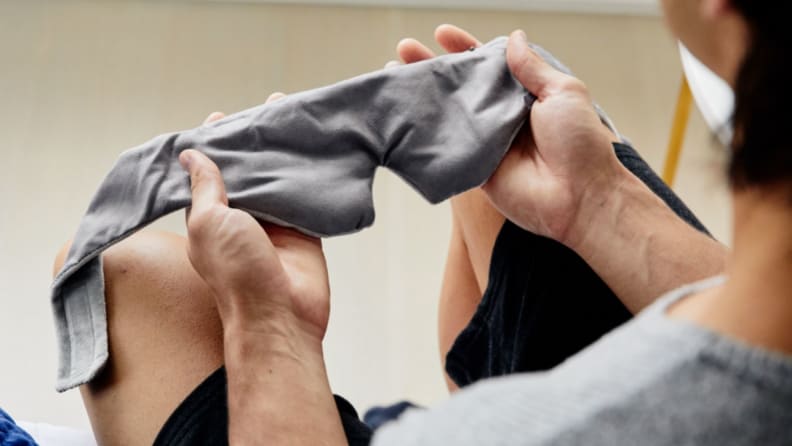Gravity Blanket's Weighted Sleep Mask: weighed down by potential
On a fundamental level, sleep masks should be comfortable and easy to use. This one is not.
 Credit:
Gravity Blanket
Credit:
Gravity Blanket
Products are chosen independently by our editors. Purchases made through our links may earn us a commission.
To me, sleep masks always seemed like a product for bougie sleepers—the folks who put cucumber slices on their eyelids, don silk robes, and have eternally new-looking white slippers. Driven by sheer curiosity as a kid, and maybe a little enticed by my perceived Hollywood glamor of sleep masks, I tried out a freebie my dad picked up on an international flight. After one night, I was hooked. I wore it consistently up to my college years. Since then, I haven't felt like I needed a mask—ambient light just doesn't bother me that much and Hollywood's allure faded (albeit only slightly). But now that I write about sleep for a living, my interest in such eye covers has been piqued once more—this time by a weighted sleep mask made by Gravity
What is Gravity and the Gravity Weighted Sleep Mask?

Gravity Blanket's Weighted Mask is designed to distribute weight to key pressure points on your face.
Gravity is best known for its weighted blankets, which launched with a Kickstarter campaign in 2017. In fact, per our tests, the company makes the best weighted blanket, the Gravity Blanket. It also sells a weighted sleep mask, for a pretty penny of $40. As Reviewed’s sleep writer, I had to try it out for myself.
The main aim of sleep masks is to block out light that might disturb your rest overnight or before your planned wakeup time. Gravity’s mask does that, but it also “distributes 0.75 to 1 pound of weighted pressure to key pressure points on the face, on areas surrounding the eyes tied to relaxation.” The company recommends wearing it for sleep, or for stress relief when traveling on planes.
The mask itself has two components: an imitation cashmere exterior, and an insert filled with glass beads, like the Gravity Blanket, to give it weight. The top of the mask has a tiny zipper, so you may remove the insert and wash the fabric cover. Small pieces of velcro keep the insert from shifting around in the cover throughout the night, and the insert itself has stitching that keeps beads distributed evenly and from moving to the areas that rest right over the eyeballs.
What’s great about the Gravity Mask?

The Gravity Mask is washable, which may be a plus for folks who suffer from allergies.
The mask felt slightly cool to the touch when I first laid it over my eyes, which was soothing. I was initially concerned that the mask might exert pressure that bothered my eyes or the bridge of my nose, and was pleasantly surprised when it was a non-issue. The mask’s design, cut, and internal stitching indeed do a good job keeping weight where you want it and not where you don’t. My first impression was that it felt nice. I liked how the weight fell on my face, it was well-distributed and did have a mild calming effect. Whether or not it’s attributable to pressure points, or if it lends enough sensation that you’re distracted from a rambling mind, I’m not sure.
As noted, the fabric cover is washable, though the company recommends doing it by hand—a minor inconvenience. This is a plus for general hygiene, as no doubt oils from the skin will transfer to the fabric while wearing it. It’s also a benefit for allergy sufferers, who can keep ahead of the dust that might accumulate over time.
What’s not great about the Gravity Mask?

Trying to put on the mask can be a more frustrating experience than it should be.
It probably won’t work for most sleepers
In my opinion, this mask has extremely limited versatility when it comes to sleeping with it on. It seems to me it’s best suited to one type of niche sleeper: people who lie on their backs and don’t move throughout the night. Unfortunately the mask’s heft and bulk make it too awkward for stomach and side sleepers to use, which I state from experience. As someone who never sleeps on her back, this proved quite the challenge in testing. I only tried the mask a handful of nights before ultimately giving up because it disrupted my ability to even doze off, let alone snooze peacefully.
When I lay on my stomach or side, the mask was pushed into my face by my pillow (and bed) in a way that’s just uncomfortable. It’s not painful, but it felt as though my face was being pressed against a pile of very tiny marbles or small, unforgiving seeds, especially when I was in a face-down position. When lying on my side, the beads don’t apply pressure all that well to where they’re supposed, because gravity is working against the Gravity Weighted Mask and pulling its contents down to the side, rather than distributing its weight on your face.
It’s awkward to put on and keep in place
The mask’s straps make it very difficult to secure behind your head if you’re not holding the front of it squarely against your face. For me, this presented a great challenge. You see, I have wavy hair that crimps under any pressure, so when donning any sleep mask, I prefer to tip my head over and secure the strap around my head, but beneath my hair, so there isn’t a visible dent in my style come morning. I couldn’t juggle holding the heavy mask, strap, and my hair well enough to really secure the thing, which meant that it slipped down my face the second I let go. Eventually I wound up putting the mask facedown on my pillow, sticking my face on it, and flipping my hair over the top of my head so I could tighten the strap as much as possible. This was more effective, partially because I could sit back up while holding the mask in place over my eyes.
For the sake of experimentation, I surrendered to having crimped hair and put it on overtop my head while sitting upright. Even then, I had problems with the mask sliding down my face before I could lie down. The straps would settle behind my ears, which would have been really bothersome for prolonged periods while sitting upright on an airplane—as if face mask elastics weren’t annoying enough. But unless I really pulled the straps hard and velcroed it tightly—and then lay perfectly still on my back—it had true wanderlust.
My roommate was curious about the mask after I described it to her one night. Naturally I grabbed it to show her. She runs hot, and noticed and appreciated how it felt cool on first impression. The wonder gave way to laughter seconds after I put it in her hands, because it’s, frankly, a little ridiculous. After a moment she set it aside and reached the best conclusion of my experience and feelings about the mask: “It just tries too hard.”
The mask can’t be heated or cooled
Unlike Gravity’s other weighted mask, the Weighted Sleep Mask was not designed for heating or cooling. Though I personally wouldn’t use a heating feature (I’m not a fan of the thought of my eyes all sweaty from a warmed mask), the option to cool masks is really nice, and could even make it easier to hit the temperature sweet-spot overnight.
The fabric isn’t my favorite
The Gravity Weighted Sleep Mask has a cashmere-like fabric that’s most noticeable on the top of the mask. Though the fabric was nice, it didn’t impress upon me quality. If I'm honest, it reminded me more of stuffed animals I had as a kid. The underside, which actually touches your face has less of a nap and isn’t as soft or plush. I didn’t mind the fabric, but I would have preferred a more smooth and, well, softer, surface resting on my face.
What are current owners saying?
Shortly after I finished testing the Gravity Mask, it went out of stock on Gravity's website. When the company restocked it, the product's reviews were no longer available. The ratings on Gravity's website were fairly high, it had just under 4 stars based on 300-plus reviews. However, the reviews were polarized with most people either loving it or hating it. One of the 174 reviewers who gave it 5 stars wrote: “Felt the difference after one night. “[It] makes me fall asleep so fast and wake up refreshed! Now, after a week I swear by it.” The second largest group of reviews—42 in total—gave it just 1 star. Some of them ran into several of the same issues I did. “It’s quite lumpy and the weight of it doesn’t allow you to sleep on your side. I have to lay on my back and not move for it to stay in one place,” a customer wrote. “The strap isn’t strong enough to hold it and [it] pulls your hair. Don’t bother with this.”
The mask also has reviews on Bloomingdale's and Amazon. On both retailers it hovers around 4 stars, and reviewers highlight similar pros and cons—some saying it's bulky, others remarking they've never slept better.
Is the Gravity Weighted Mask worth it??

At the end of the day, I think the Gravity Weighted Sleep Mask will only suit a small fraction of people.
For the vast majority of people, I think this mask isn’t worth the relatively high cost. Instead of providing comfort and relaxation for me, it made it harder for me to doze off while lying on my side or stomach. That’s not to mention the challenges there are in securing it and its propensity to shift around on your face if you don’t lie perfectly still.
In addition, Gravity’s Weighted Sleep Mask is high stakes—you can’t return it if you find it wasn’t a worthwhile investment for you. Per the website: “For hygienic reasons, this product is non-returnable and non-refundable.”
If you’re desperately in need of a weighted mask and sleep only on your back, motionless all night long, it might be the product for you. Even then, I think the price is tough to justify—especially given the company’s restrictive return policy. Unfortunately this mask is far more of a gamble than sure-fire winner.
